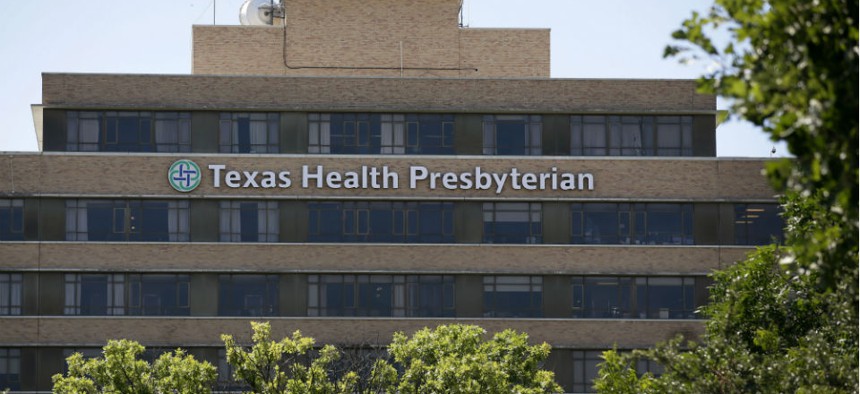
Tony Gutierrez/AP
The Ebola Plan Was in Place, So Why Did It Falter in Dallas?
CDC's plans are only as effective as the individual hospitals and doctors tasked with carrying them out.
A patient displaying symptoms of Ebola was at large among the American public for several days last week, and it happened because of a hospital miscommunication.
This wasn't supposed to happen, and it didn't have to. In preparation for a possible case in the United States, the Centers for Disease Control and Prevention has been educating the health community for months on the virus and offering guidelines to hospitals for detecting and treating potential Ebola patients.
CDC called for medical facilities to be alert for Ebola-like symptoms, including high fever, severe headache, muscle pain, vomiting, diarrhea, and abdominal pain. They were also supposed to inquire about possible exposure, through contact with a suspected victim or travel to the West African countries suffering from the Ebola epidemic. And if they found a patient who had a fever within 21 days of high-risk exposure, they were supposed to test the individual for the virus.
But CDC's plans are only as effective as the individual hospitals and doctors tasked with carrying them out. And a mix-up in Dallas last week is a red flag for potential future cases.
The first case of Ebola diagnosed in the U.S. was confirmed by CDC on Tuesday at Texas Health Presbyterian Hospital in Dallas.
But the test was not administered until the patient's second visit on Sunday. The patient went to the emergency room two days prior, on Friday, but was diagnosed with a low-grade viral fever and sent home with antibiotics, leaving many wondering why he was not questioned about his travel history.
As it turns out, he was.
A nurse asked the patient during his ER visit whether he had recently been in one of the West African countries where the Ebola outbreak is rampant, and he said he was visiting from Liberia, said Mark Lester, executive vice president of Texas Health Resources, at a news conference in Dallas on Wednesday. But that information "was not fully communicated throughout the whole team."
The man flew to the U.S. from Liberia on Sept. 19 and arrived in Dallas to visit family the next day. He began feeling ill four days later, and went to the ER with a fever on Friday. Doctors sent the patient home, and he was admitted again two days later, when he was placed under isolation, and ultimately diagnosed with Ebola. He is reportedly in serious condition.
That two-day gap is critical time the patient spent sick without treatment, his condition deteriorating—and two more days when he could have unknowingly infected others.
Texas Gov. Rick Perry said Tuesday that some schoolchildren were in contact with the Ebola patient, though none have presented symptoms yet.
A Dallas County health official said they are currently monitoring 12-18 people that had contact with the Ebola patient, The Dallas Morning News reported. CDC has sent nine workers to Dallas to track anyone that might have been infected.
It is not clear whether the encounters were before or after the patient's first hospital visit.
The initial oversight comes despite the fact that staff at Texas Health Presbyterian Hospital of Dallas did a run-through of procedures to follow if an Ebola case presented there just last week, according to The Dallas Morning News.
"We were prepared," Dr. Edward Goodman, an epidemiologist at the hospital, said Tuesday. "We have had a plan in place for some time now in the event of a patient presenting with possible Ebola. We are well-prepared to deal with this crisis."
But effectively dealing with the virus is contingent on first detecting it, and detecting it fast.
"We're reiterating the message for every health worker in this country—think about travel history. If someone's been in West Africa within 21 days and they've got a fever, immediately isolate them and get them tested for Ebola," CDC Director Thomas Frieden told CNN on Wednesday morning. "We know that in busy emergency departments all over the country, people may not ask travel histories. I don't know if that was done here. But we need to make sure that it is done going forward."
NEXT STORY: Making Data Real: Lessons From Federal Leaders







